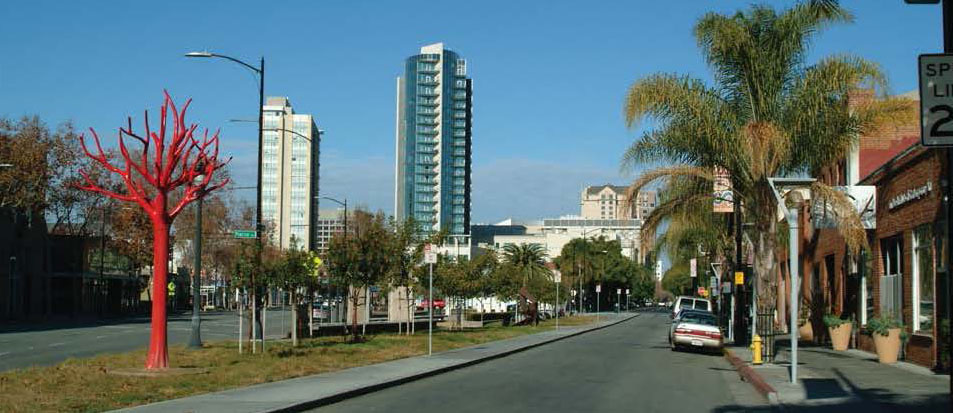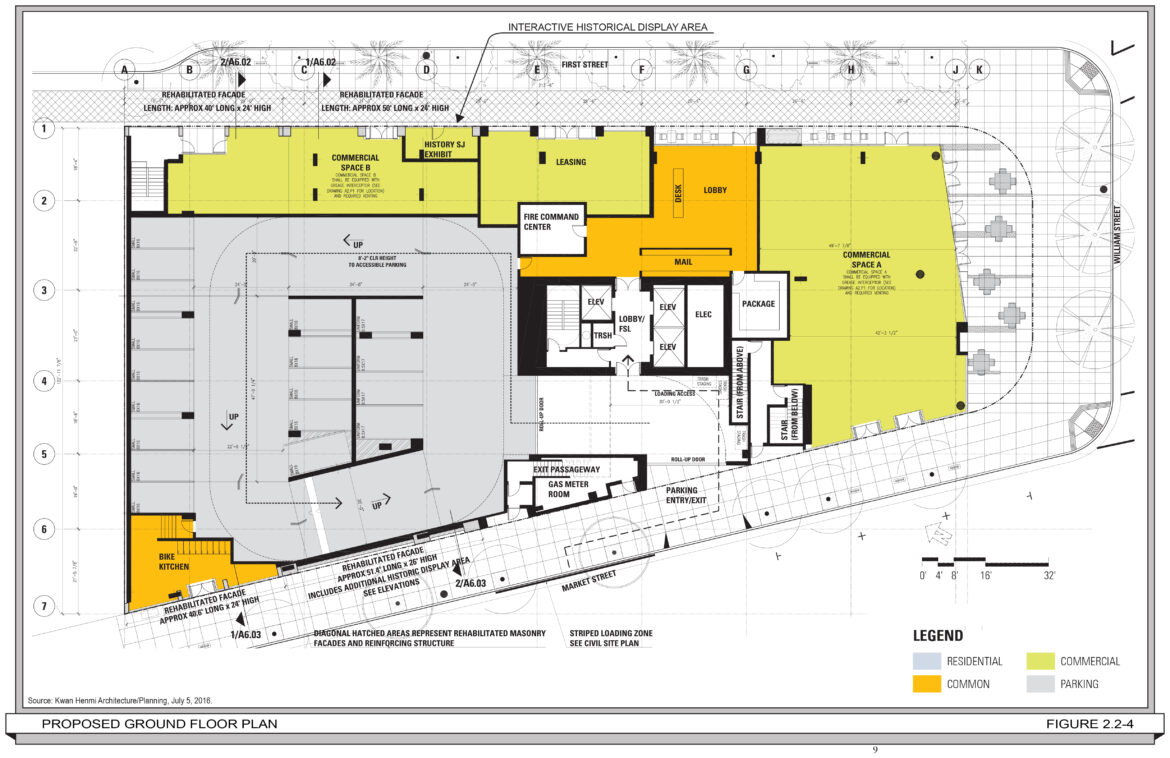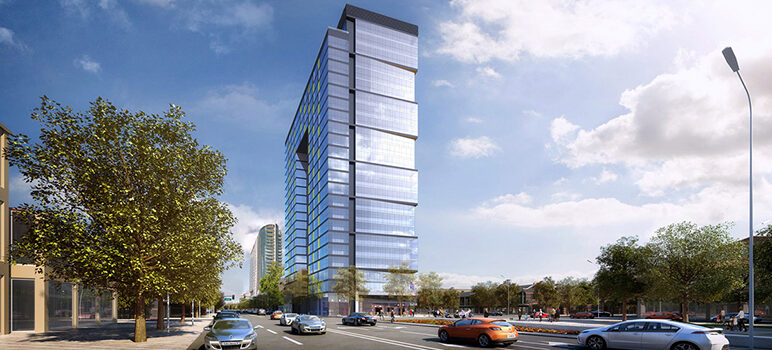A project promoted as a 24-story luxury housing project in downtown San Jose’s trendy SoFA arts district will become a Section 8 affordable housing project, according to planning documents filed with Santa Clara County.
Core Development Vice President Christopher Neale confirms that “it was going to be a market rate project” and that it will now be mostly affordable because of the availability of county Measure A money and a desire to keep the project moving forward.
According to the project summary published by the county’s Office of Supportive Housing and Community Development on March 10, the Gateway Tower will consist of 220 below-market-rate apartments for households making between 30 percent to 80 percent of average median income.
Fifty-five of the units in what is now described as a 21-story highrise will be “set aside as permanent supportive housing for formerly homeless households, and 18 units will be set aside for rapid rehousing,” a form of temporary shelter for homeless persons with income who are seeking permanent housing.
The project developers, The Core Companies, have applied to receive 110 of the county’s allocation of project-based vouchers, by which the U.S. Department of Housing and Urban Development subsidizes monthly rents.

Gateway Towers would rise far above the otherwise-low-slung SoFA District skyline.
In addition, the project would receive $64 million from Measure A and another $13.75 million subsidy from the city of San Jose—bringing the public financing to $353,409 per affordable unit. The $64 million would be the biggest allocation of funds to date from the county bond measure passed in 2016 to build housing for the homeless.
Submitted to San Jose in 2015, the Gateway Tower project is described on its developer’s website as “a 24 story, 30-unit, luxury high-rise apartment building located in the SoFA district of downtown San Jose” that’s “designed to appeal to the Silicon Valley’s sophisticated renter.” “Gateway Tower will be the place to live in the South Bay to get that dynamic, urban-living experience,” the website adds.
The project site is located at South First, William and Market streets, just north of Parque de los Pobladores, which has been renovated with private and public funds.
A “bike kitchen” and 77 bicycle parking spaces would be provided, along with a “wide sidewalk area” that “could be used as an outdoor seating area for residents and commercial uses.” The project summary also says that “amenity spaces for residents would be provided on the sixth and 24th floors of the building” and that “the proposed units would range in size from approximately 470 square feet to 1,720 square feet.”
Neale said that while there may be some value engineering of appliances and finishes with the change from market rate to affordable, the exterior architecture won’t change and the two amenity decks will remain.
Downtown San Jose’s SoFA District has been awash in a wave of speculative buying.
The Valley Title parking lot was purchased in 2018 by a consortium led by Gary Dillabough for a reported $64 million and the former Bo Town restaurant site was purchased by a development group.
A lot across from the La Penita restaurant building, two blocks to the south, sold in March for $16.5 million—which pencils out to an eye-popping land cost of $1,896 a square foot—more than triple what other properties have sold for—according to RealtyTrac.
Another proposed SoFA district residential tower, a 30-story building designed by Campbell’s Anderson Architects, made the news earlier this month. It would create 354 affordable units near the corner of South Second and East Reed streets.
Gateway Tower has been controversial because it will demolish two century-old buildings in the low-slung SoFA neighborhood, including a local historic landmark where Charles Herrold, the first radio broadcaster, ran his pioneering wireless laboratory.
A draft environmental impact report stated in August 2016 that the tower “would overwhelm the historic buildings on and adjacent to the site in terms of size and massing” and “will result in an adverse environmental effect on a historic resource.”
“This impact will occur with the partial demolition of this significant resource, an action that will leave only the exterior storefronts intact. Proposed project components, such as including the preservation and rehabilitation of the storefront walls, and incorporation of a permanent window exhibit that commemorates Charles Herrold and his contributions to the development of broadcast radio, do not reduce the impacts to the historic resource to less than significant level,” the impact report continued.
“The project will also negate the potential of this property for listing on the National Register of Historic Places. ...The project is inconsistent with the Secretary of the Interior’s standards for the treatment of historic properties, and appears to be inconsistent with the Envision San Jose 2040 General Plan policies pertaining to the preservation of city landmarks.”
Despite the historical concerns, the City Council went ahead and approved the luxury highrise, but the project has sat for several years while Core sought financing.
If the funding for Gateway Tower is approved, Core will become the largest recipient of Measure A funding, receiving $101.75 million between four projects—a quarter of the money budgeted to date. Neale says the number’s so large “because Gateway Tower is such a big project” and represents 60 percent of the funds earmarked for Core’s projects.
Core is also receiving Measure A funds to refinance and renovate two 17-year-old apartment complexes on Monterey Road south of downtown, and is in line to get $38.8 million in subsidies, $23.5 million of it from the county, to build the “Agrihood” affordable senior housing project in Santa Clara adjacent to Santana Row and the Westfield Valley Fair shopping center.
Core Development and its partner in two other projects, Republic Urban Properties, have generously contributed to the campaigns of Measure A’s two champions, Supervisors Cindy Chavez and Dave Cortese, over the years. Most recently, in February 2020, Core principals David and Chris Neale gave $9,400 to Cortese’s campaign for state Senate.
On Tuesday, county supervisors reviewed the project list in hopes for moving Measure A projects forward. Less than half the proceeds from a $250 million bond sale have been spent, and just 146 units of affordable housing have been built since the $950 million homelessness-eradication bond measure was approved by voters in 2016.

A floor plan of the proposed development.
This report is part of a longer look at Measure A which ran in Metro, “Billion Dollar Boondoggle.” Disclosure: Dan Pulcrano has operated a business on South First Street since before it was known as SoFA, and owns a building there. Some updates have been made to this post as additional facts became known.


How much does this pencil out to per unit of housing that taxpayers will be footing the bill for? Is it correct to assume that this form of housing pays NO property tax thereby increasing the burden on the ever-shrinking middle class? it seems this is a zero sum game. The more of this is the less of that. Can we assume that we will never get ahead in this scheme as more and more people will be attracted to free/no rent?
Instead of having “luxury condos with the “new urban tech-sters” shelling out $$ to support local establishments, downtown will get no/low income persons that will not contribute to the struggling local business’. Shameful and short-sighted thinking on the part of whoever does this kind of thinking.
When I was young, my family lived on the outside of town as we couldn’t afford to live “in-town”. But now those who cannot afford to provide themselves with a home have become the new “Kings” in the political world.
And all of this speaks very poorly about how the city treats it’s historical heritage. History is about preservation. Without preservation ~ ~ ~there is no history. As a city loses it’s history – it becomes less and less significant.
I think the writing is on the wall that this Google Savior myth is not going to pan out. First, they oversell everything they do. Second COVID is letting people work remotely, and if Google can do one thing well is spy on people and see what they are doing. They must have deduced what productivity they are losing from remote workers is less than the office cost burden.
As annoying as these project seem on the surface, it is better to warehouse poor people in new LIHTC and Section 8 projects than 60+ year old rent controlled units. These properties need market rent incentives to justify the cap improvements they need to extend their economic life. Poor people always cost money, it is just where do you pay it. In the end, this building will get built, the tax credits and BMR constraints will end, and SJ will have 2 sets of Market Rent units to take some pressure of rent levels, which even a landlord will admit are too high.
I added the price per unit after the article posted. It’s $353,409 in city/county subsidy per affordable unit, which is one of the highest subsidies amongst the Measure A projects. That’s in addition to the federal subsidy of monthly rent payments through the project based vouchers.
for that amount of $ the taxpayers may as well be housing the homeless at the Fairmont. 3 squares a day included. Do we have overpaid, underthinking bureaucrats running this game show or calculating politicians looking at the next rung of the political ladder – – at our expense?
Welfare is transfer of wealth from the middle class to the rich. ALWAYS keep that in mind. There is nothing more lucrative than dependent poor people, no checks the price and they certainly never get to hold the money.
the developers have been sitting on this project for some time waiting to build their upscale “luxury” condos. something did not work out so they went to the politicians for a “bail-out” to put up low income-affordable. So yes the rich are getting some taxpayer wealth here – but it is a one time deal.
Instead of a bank/mortgage company getting monthly payments for those luxury condos – the taxpayers will be paying forever for some to live there – taxpayers in effect become the landlord/owners for which they will receive no rental income. It would be like a family getting to move into your extra bedroom SJ ~ rent free! And the politicians come away looking like saviours with someone else’s money. ALWAYS keep that in mind.
I am with ya, but I’ll take making 25000 a year off 100 people for 25 over looking like a savior, every single time
SJ, any advice for those of us thinking of relocating? The Salton Sea area has alway appealed to me. You seem familiar with the area, what can I hope to find for a one-bedroom at something less than $3k/mo?
Well I would go Buffalo WY, you could get this for about 250, id say…
https://www.zillow.com/homedetails/502-Fullerton-Pl-Buffalo-WY-82834/110333529_zpid/
Absaroka County, perhaps you can even say Hi to Sheriff Longmire, but dont buy from anyone name Barlow
Now if you are into lakes and Christmas, there is always Whitefish…
You gotta dig a bit deeper to get a decent sized place, so probably go with a condo. HoA is pretty reasonable a $110/month.
https://www.zillow.com/homedetails/6213-Shiloh-Ave-UNIT-D-Whitefish-MT-59937/78143795_zpid/
Well, at least it keeps them out of my ‘hood”
They probably found out that the office of supportive housing will literally allow landlords to do anything thing they want. Bedbugs? Just fine. Tenants who assault other tenants? Not an issue. Filth smeared on walls crawling with cockroaches? Overactive imaginations on the part of tenants. Refusal to keep records? Hey, staffing problems but they are doing a great thing, don’t you know. These projects cost millions of dollars, sure, but there is a reason people would rather sleep on the street, and it isnt drugs or mental illness. Stop funneling money to Charities Housing and their ilk, and use the money effectively, for God’s sake
This just adds housing project to the downtown San Jose landscape. There are similar units to this on Keys and S 2nd st and on S 3rd st. All rent controlled and homeless. Police are there every night with some issues. Crime in this area has increased and so has the homeless population. Gathering the low income and homeless on high rise apartments is not the answer. Ask Chicago how Cabrini green went.
Cabrina Green was leveled.
Tomorrow’s slums built today.
San Jose
The slum of Silicon Valley
Well if it’s the art district I suppose it needs to house poor artists? Thanks I hate it.
Thats SoFA to you, buster!
Let’s go for it! I accept the whole new deal for affordable housing in a beautiful tower. Kudos to SJ!! Take that Toronto.
If you can’t afford to live here then move.
This message is mostly for the young. You need to become a property owner as fast as you can. If that means you have to move out of the area then do it. Find a part of the country being able to live like an American by owning a single family home.
UNLESS you are in tech then from an economic point of view then you probably shouldn’t be here in the first place.
Live in a homeless shelter for a year working and within a year you should have $20K+ in the bank.
> the project would receive $64 million from Measure A and another $13.75 million subsidy from the city of San Jose—bringing the public financing to $353,409 per affordable unit.
> “Gateway Tower will be the place to live in the South Bay to get that dynamic, urban-living experience,” the website adds.
Are we in some kind of urban competition with San Francisco, Calcutta, and Mexico City?
“Our bums live better than your bums”?
I’m willing to lose to Calcutta.
Here’s another “affordable housing” option for San Jose’s micro-squalor community:
— bus tickets to San Francisco. And, for what the micro-squalor community is costing San Jose, limousine rides to San Francisco might even be justified.
At the end of the ride to SF, luxury awaits our underserviced houseless: accomodation in the beautiful, elegant, Mark Hopkins Hotel.
https://www.city-journal.org/san-francisco-hotel-motel-plan-for-homeless
It would be cruel of San Jose to deny our suffering street denizens the chance of a lifetime to live in splendor on the 20th floor of the Mark, just next door to Barbra Streisand or The Oprah.
This is the stupidest thing anyone could do to downtown SJ. Let’s call this what it is: a housing project on steroids. I don’t know of a single project of this type anywhere that hasn’t ended up a filthy, unlivable dump riddled with crime and drugs.
The “Gateway” moniker was chosen because this building will be located at the southern end of downtown on a major artery. Just what people want to see when they approach the city center — a 24 story ghetto surrounded by garbage.
This couldn’t reek more of backroom deals made between politicians and developers, neither of which are concerned about local taxpayers, except when they want us to foot the bill for something. And anything Cindy Chavez is involved with is most assuredly a shady endeavor. We are being railroaded and robbed. I voted against Measure A for exactly this reason.
I thought that when civic leaders, the Chamber of Commerce (“Silicon Valley Group” is BS) and the Downtown Association spoke of a 24-hour downtown that they didn’t mean a 24/7 beehive full of criminals and their related activity. Potential low income residents familiar with the concept of decency deserve something better than what will surely become a Cabrini Green situation. I am seriously annoyed about how the subsidization of these units pencils out for us hard working taxpayers. This project needs to scuttled for the multitude of reasons Dan has outlined above.
> This project needs to scuttled for the multitude of reasons Dan has outlined above.
What reasons?
It seems that all he did was recited some project names, sources of funds, number of units, blah, blah, blah.
Maybe I’m dim, but it wasn’t clear to me if he was for or against any of the projects.
Imagine that, journalism without a discernible slant. How refreshing.
I’m thinking this is a sign that the back is breaking on the great downtown San Jose rejuvenation. Could the Google village become another Coyote Valley? The longer covid rages, the less likely that happens at all.
Dan Pulcrano -please note: if core has donated to the campaign funds of Cortese and Chavez and then rec’d county funds for this project- – – – – there are state and local statutes that forbid this type of “money movement.” or as we say in my country – – THIS IS ILLEGAL.